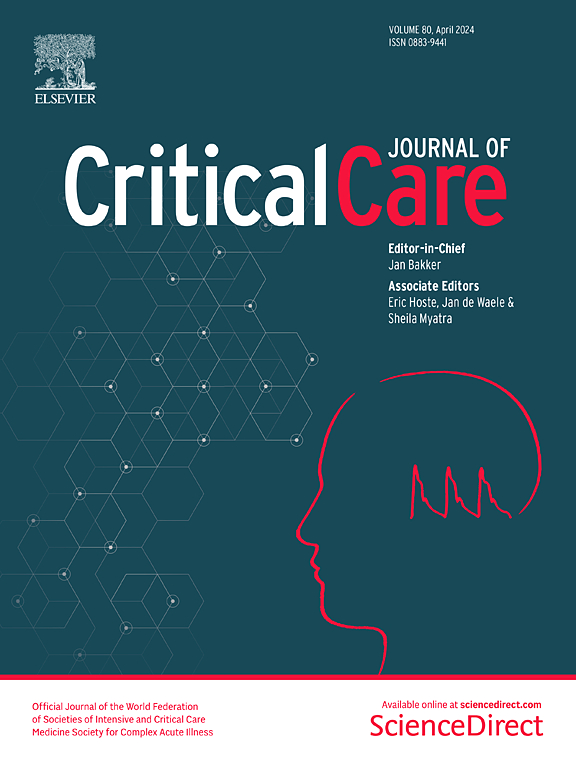慢性移植物抗宿主病的异基因造血干细胞移植受者的重症监护疾病
IF 8.8
1区 医学
Q1 CRITICAL CARE MEDICINE
引用次数: 0
摘要
慢性移植物抗宿主病(cGVHD)是同种异体造血干细胞移植(alloo - hsct)后的主要长期并发症。然而,它对危重患者同种异体造血干细胞移植患者预后的影响很少被评估。我们对2015年1月1日至2020年12月31日期间入住14个法国重症监护病房(icu)的同种异体造血干细胞移植接受者进行了一项多中心队列研究的后分析。主要终点为入院后90天死亡率。cGVHD的患病率为10%(114/1164),其中一半患者的病情严重。最常见的表现是皮肤受累(94%),其次是胃肠道(56%)、肝脏(28%)和肺部(19%)。入院ICU的主要原因是急性呼吸衰竭(43%),65%的患者出现多器官功能障碍。90天总生存率为61%,3年生存率为40%。ICU入院时序贯器官衰竭评估评分是90天死亡率的唯一独立预测因子(HR/point 1.32 [95% CI 1.21-1.46];p < 0.01)。cGVHD严重程度对生存率无显著影响。cGVHD患者的生存率与控制急性GVHD或无GVHD患者相当(90天:61%对55%和66%;3年:40% vs. 32%和47%)。在危重的同种异体移植受者中,cGVHD的存在或严重程度与生存无关,不应影响患者是否入住ICU的决定。然而,对于严重肝或肺受累的患者,应认真讨论护理目标。回顾注册。本文章由计算机程序翻译,如有差异,请以英文原文为准。
Critical care illness in allogeneic hematopoietic stem-cell transplantation recipients with chronic graft versus host disease
Chronic graft-versus-host disease (cGVHD) is a leading long-term complication following allogeneic hematopoietic stem-cell transplantation (Allo-HSCT). However, its impact on outcomes in critically ill Allo-HSCT recipients has little been evaluated. We conducted a post hoc analysis of a multicenter cohort study involving Allo-HSCT recipients admitted to 14 French intensive care units (ICUs) between January 1, 2015, and December 31, 2020. The primary endpoint was 90-day mortality after admission. The prevalence of cGVHD was 10% (114/1164), with a severe form of the disease in half the patients. The most common manifestation was skin involvement (94%), followed by gastrointestinal tract (56%), liver (28%), and lungs (19%). The primary reason for ICU admission was acute respiratory failure (43%), with 65% of patients presenting with multi-organ dysfunction. Overall survival was 61% at 90 days and 40% at 3 years. The Sequential Organ Failure Assessment score at ICU admission was the only independent predictor of 90-day mortality (HR/point 1.32 [95% CI 1.21–1.46]; p < 0.01). cGVHD severity did not significantly influence survival. Patients with cGVHD had comparable survival rates to those with controlled acute GVHD or without GVHD (90-day: 61% vs. 55% and 66%; 3-year: 40% vs. 32% and 47%). In critically ill Allo-HSCT recipients, the presence or severity of cGVHD is not associated with survival and should not influence the decision to admit or not the patient to the ICU. However, careful discussions about the goals of care should be undertaken in patients with severe hepatic or pulmonary involvement. Retrospectively registered.
求助全文
通过发布文献求助,成功后即可免费获取论文全文。
去求助
来源期刊

Critical Care
医学-危重病医学
CiteScore
20.60
自引率
3.30%
发文量
348
审稿时长
1.5 months
期刊介绍:
Critical Care is an esteemed international medical journal that undergoes a rigorous peer-review process to maintain its high quality standards. Its primary objective is to enhance the healthcare services offered to critically ill patients. To achieve this, the journal focuses on gathering, exchanging, disseminating, and endorsing evidence-based information that is highly relevant to intensivists. By doing so, Critical Care seeks to provide a thorough and inclusive examination of the intensive care field.
 求助内容:
求助内容: 应助结果提醒方式:
应助结果提醒方式:


